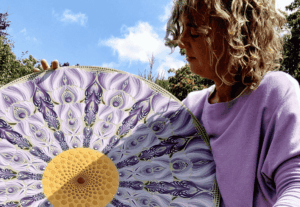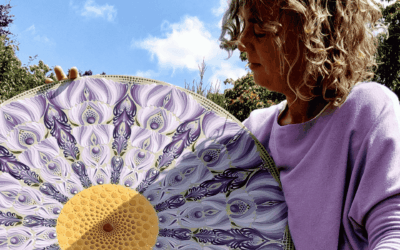In my courses and at exhibitions, I am often asked, ‘How do you manage to make the mandalas so perfect?’ But they are not perfect – at least not in the sense of absolute symmetry or millimetre-precise spacing. What makes them appear harmonious is not the perfection of each individual dot or strokes, but the overall picture created by the connection of all these small elements.
The beauty of imperfection
When painting mandalas, I often catch myself wondering whether one stroke is really exactly the same as another, whether a dot is a little too big or the spacing is even enough. The truth is: it isn't. And that's perfectly fine. Every dot, every line contributes to the overall effect – and in the end, it looks perfect. Perfectly imperfect.
I have learned that it is precisely these small irregularities that bring a mandala to life. If I tried to place every dot exactly the same, something would be missing – the energy, the lightness, the life. It's a bit like life itself: here, too, it is often the small imperfections that make us who we are, that make us seem unique and real.
The entirety is greater than the sum of its parts
The perfect harmony of a mandala does not come about because each point is perfect in itself, but because together they form a larger whole. This reminds me how important it is in life not to focus solely on the details, but to keep the bigger picture in mind. Even if not every step is perfect, the result can still be beautiful and harmonious.
Perhaps this can also be applied to our society: just as a mandala only achieves perfection through the interaction of its individual points, a community also thrives when each person finds their place – regardless of perfection or conformity. It is the different facets that can form a strong, harmonious coexistence when they complement each other and do not conflict. Diversity can thus contribute to a vibrant overall picture without everything having to be perfect or uniform.
The art of acceptance
What I have learned from mandala painting is one thing above all else: acceptance. Acceptance that not every stroke has to be perfect. When I look at my very first mandala, for example, which is anything but perfect and yet perfect, it reminds me exactly of this realisation. It was anything but symmetrical, the spacing wasn't always even, the dots were irregular – and yet it was the first piece that showed me how something magical can be created, even if it's not perfect. It has character, it tells a story and it reminds me that beauty doesn't always have to be flawless.
Perhaps we should also trust more often in everyday life that imperfection is not a bad thing, but leaves room for growth and uniqueness.
If you are curious to see how this perfect imperfection looks in my work, please feel free to visit my shop and be inspired. Perhaps you will find a mandala there that reminds you of the beauty of small imperfections.







0 Comments